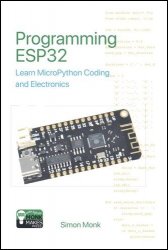Programming ESP32: Learn MicroPython Coding and Electronics
- Добавил: literator
- Дата: 24-09-2024, 02:38
- Комментариев: 0
 Название: Programming ESP32: Learn MicroPython Coding and Electronics
Название: Programming ESP32: Learn MicroPython Coding and ElectronicsАвтор: Simon Monk
Издательство: MonkMakes Press
Год: 2024
Страниц: 187
Язык: английский
Формат: pdf
Размер: 24.1 MB
This book will teach you Python programming and some basic electronics without assuming any prior knowledge of either subject. The book initially focusses on Python programming, building up a Morse Code example. The book is suitable for most ESP32 boards, but concentrates on the most popular ESP32 Lite and the ESP32 DevKit 1. In the chapters on electronics, breadboard layouts are provided for both of these boards.
ESP32 is a family of processors developed by Espressif Systems (that’s where ESP comes from in the name) that, notably, includes WiFi and Bluetooth capabilities. The processor chip itself is used on many different development boards. Sometimes the processor is placed on the board directly but, at other times, a module is placed on the board. This module, that encloses the processor and a chip, is covered by a metal cap; its design complies with international standards - CE marked for the EU and FCC for the United States.
Discover how to:
Flash Python firmware onto an ESP32 board
Install and use the Thonny Python editor and upload programs on to your ESP32
Write simple programs to control the ESP32 in Python
Structure you programs with functions and modules
Make effective use of Python Lists and Dictionaries
Attach sensors, LEDs, displays and servomotors to an ESP32 and to program them
Make use of the ESP32s WiFi capabilities to use the ESP32 as a web server and to call web services on the Internet
Learning to program, like any skill, requires practice and simple straight-forward examples that you can work through. In this book, you will be led step-by-step through example programs, intermingled with explanations and background.
The first chapter is an introduction to the ESP32 and the various development boards that use this chip.
Chapter 2 will help you get your computer set up and ready to start programming ESP32. This includes installing USB drivers and Thonny – a good code editor to get started with.
In Chapter 3, you will start interacting with Python and learn how to write simple programs using conditional statements and loops. You will also learn how to control the built-in LED on your ESP32 board.
Chapters 4 to 6 explore Python further, developing a complex Morse code translation program that blinks out messages using the built-in LED. Along the way you will learn about Python lists, dictionaries, functions and modules.
Chapters 7 to 9 look at how you can use your ESP32 to interact with other electronics, including LEDs, servomotors and sensors of various types.
Chapter 10 shows you how your ESP32 can connect to your local network and hence out to the world-wide web. You will learn how to make your ESP32 act as a web server and also interact with web services on the internet.
Chapter 11 shows how you can attach OLED display modules and Neopixel displays to your ESP32 using a clock example.
The final chapter is concerned with more advanced features of the ESP32 including advanced input/output features such as high-speed PWM, timers, interrupts and sound generation.
Скачать Programming ESP32: Learn MicroPython Coding and Electronics
Внимание
Уважаемый посетитель, Вы зашли на сайт как незарегистрированный пользователь.
Мы рекомендуем Вам зарегистрироваться либо войти на сайт под своим именем.
Уважаемый посетитель, Вы зашли на сайт как незарегистрированный пользователь.
Мы рекомендуем Вам зарегистрироваться либо войти на сайт под своим именем.
Информация
Посетители, находящиеся в группе Гости, не могут оставлять комментарии к данной публикации.
Посетители, находящиеся в группе Гости, не могут оставлять комментарии к данной публикации.
